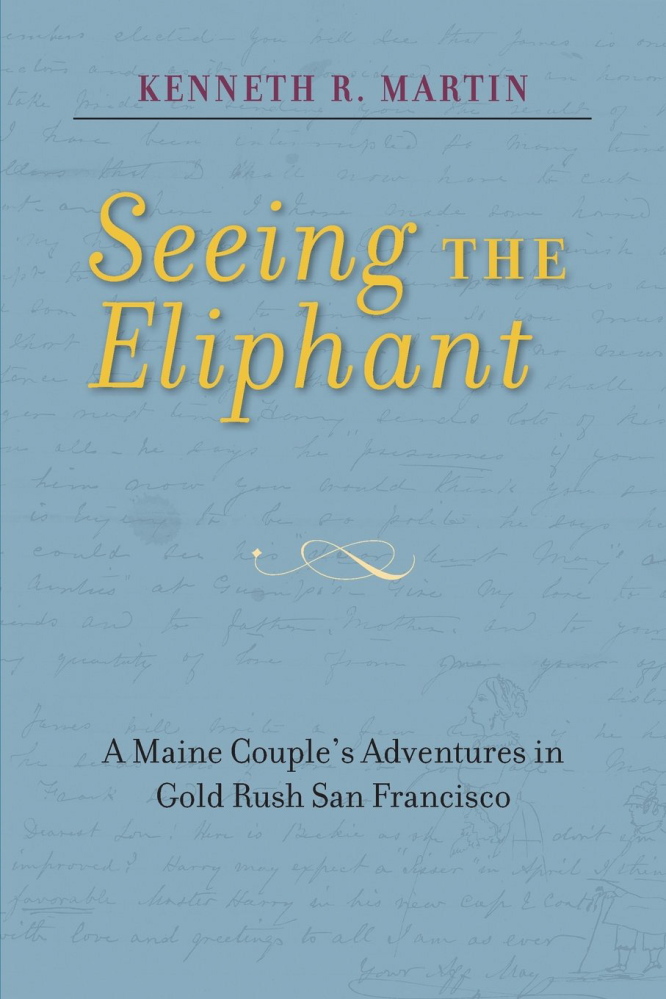Kenneth R. Martin has written about adventuresome Maine characters before. His celebrated book “Patriarch of Maine Shipbuilding” traced the life of schooner builder Gardiner G. Deering. Now he turns to the White family of Gardiner and their adventures during the California Gold Rush.
Bill King, a descendant of James and Rebecca White, had collected letters from the traveling couple. Martin, with a great deal of help from California researcher D’Arcy James, turned them into a two-coast saga. The resulting “Seeing the Eliphant: A Maine Couple’s Adventures in Gold Rush San Francisco” is interesting.
To begin with Martin notes: ” ‘Seeing the elephant’ (or ‘eliphant’ as James White put it) was a 19th-century phrase for facing difficulty or danger successfully. Given the large number of elephants the Whites confronted, it seemed an apt name for their story.”
There were difficulties faced by the writer-historian himself, and he writes of “seven months of total Gold Rush immersion.” Martin provides notes, sources and a first-rate index. The text itself is divided into nine chapters charting the rise and fall of family fortunes.
There is no doubt that Martin imparts a great deal about the 1849 Gold Rush and the great Yankee exodus from the East Coast.
The reader gets a complete picture of early San Francisco, the travel routes around the Horn, the trek across Panama and Nicaragua, and the struggle between rival transportation companies.
There is an ample portrait of American adventurer Col. William Walker, who seized Nicaragua, and of early rough justice on the American frontier.
This is fun stuff, and it shows how the West was won for the United States.
However, our “Maine Couple’s Adventures” element is often overwhelmed by context. For example, the author is not certain when James White first went to San Francisco or how he got there.
This is managed by slight of text and footnotes, which do not mar the storyline but are a big deal. A note says that our hero was listed as a “trader” in Gardiner, Maine, in 1850 and was not a member of the prestigious Society of California Pioneers founded that same year. Even his death date – 1824 or 1827 – is in question.
To be fair, the reader is told in the opening chapter that “the purpose of this book is to connect the known pieces of James and Rebecca White’s lives into a coherent story. It won’t be easy, but it surely will be interesting.”
Interesting yes, but somehow this reviewer was always thirsting for a bit more depth.
We learn of James White’s first financial loss at the hands of the notorious Harry Meiggs and that White rose to the top rank at the legendary Ophir Silver Mining Company in Nevada. Yet, things are often sketched in.
We are told that, in the early 1860s, Rebecca “could now contemplate Gardiner (Maine) without longing and savor the continuity between her old life there and her new one in San Francisco. Judging from her correspondence, she and James had drawn closer together.”
This is probably a correct assumption, but to my mind, knowledge of general history and speculation about remaining family papers, with missing pieces, makes the story a tad thin. Perhaps this is quibbling. Despite it, the reader learns a great deal about the Gold Rush.
William David Barry is a local historian who has authored/co-authored seven books, including “Maine: The Wilder Side of New England” and “Deering: A Social and Architectural History.” He lives in Portland.
Send questions/comments to the editors.



Success. Please wait for the page to reload. If the page does not reload within 5 seconds, please refresh the page.
Enter your email and password to access comments.
Hi, to comment on stories you must . This profile is in addition to your subscription and website login.
Already have a commenting profile? .
Invalid username/password.
Please check your email to confirm and complete your registration.
Only subscribers are eligible to post comments. Please subscribe or login first for digital access. Here’s why.
Use the form below to reset your password. When you've submitted your account email, we will send an email with a reset code.